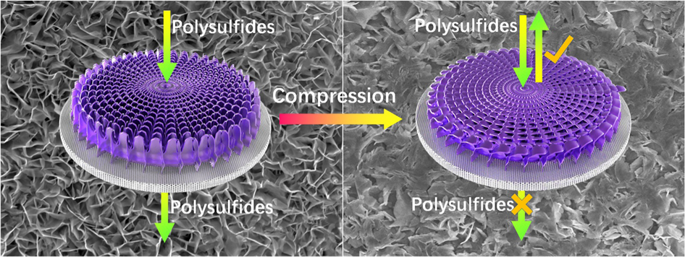NPG Asia Materials ( IF 9.7 ) Pub Date : 2019-10-11 , DOI: 10.1038/s41427-019-0159-1 Shaozhuan Huang , Ye Wang , Junping Hu , Yew Von Lim , Dezhi Kong , Lu Guo , Zongkui Kou , Yaxin Chen , Hui Ying Yang

|
Modifying a polypropylene (PP) separator with a polysulfide barrier layer can improve the cycling performance of lithium–sulfur (Li–S) batteries. However, conventional slurry-coating- and vacuum-filtration-designed barriers usually show poor particle connection and require extra binder. Herein, we propose a facile in situ growth method and a subsequent compression strategy to design multifunctional NiCo2S4 (NiCoS) nanosheet arrays on a PP membrane for high-performance Li–S batteries. The in situ grown NiCoS nanosheet arrays are interconnected, conductive and closely adhered to the PP membrane without using any binder. After mechanical compression treatment, the overall NiCoS film is compacted, lightweight (0.148 mg cm−2) and ultrathin (0.8 μm). Density functional theory calculations combined with adsorption and diffusion tests prove that the NiCoS nanosheets have highly efficient physical/chemical entrapping capabilities for preventing polysulfide shuttling. Moreover, in situ electrochemical impedance spectroscopy demonstrated that the NiCoS barrier could efficiently suppress polysulfide diffusion and concurrently facilitate redox reactions. When applying this multifunctional separator, a sulfur/carbon nanotube (S/CNT) cathode with high sulfur content (75 wt%) delivers significantly improved long-term cycling performance, with 0.056% capacity decay per cycle over 500 cycles. This work opens up new opportunities to design multifunctional separators by an in situ growth strategy for high-performance Li–S batteries.
中文翻译:

原位生长的压缩NiCo 2 S 4阻挡层,可有效持久地捕获多硫化物
修改带有多硫化物阻挡层的聚丙烯(PP)隔板可以提高锂硫(Li–S)电池的循环性能。然而,常规的淤浆涂覆和真空过滤设计的屏障通常显示出较差的颗粒连接并且需要额外的粘合剂。在这里,我们提出了一种简便的原位生长方法和随后的压缩策略,以在高性能Li–S电池的PP膜上设计多功能NiCo 2 S 4(NiCoS)纳米片阵列。原位生长的NiCoS纳米片阵列相互连接,导电并紧密粘附到PP膜上,而无需使用任何粘合剂。机械压缩处理后,整个NiCoS薄膜被压实,轻巧(0.148 mg cm -2)和超薄(0.8μm)。密度泛函理论计算与吸附和扩散测试相结合证明,NiCoS纳米片具有高效的物理/化学截留能力,可防止多硫化物穿梭。此外,原位电化学阻抗谱表明,NiCoS势垒可以有效地抑制多硫化物的扩散并同时促进氧化还原反应。当应用这种多功能隔板时,具有高硫含量(75 wt%)的硫/碳纳米管(S / CNT)阴极可显着改善长期循环性能,在500次循环中每循环容量衰减0.056%。这项工作为高性能Li–S电池的原位生长策略提供了设计多功能隔膜的新机会。


























 京公网安备 11010802027423号
京公网安备 11010802027423号